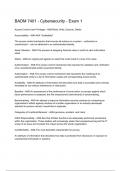Exam (elaborations)
BADM 7401 - Cybersecurity - Exam 1 Questions with 100% correct answers | verified | latest update 2024
- Course
- Institution
BADM 7401 - Cybersecurity - Exam 1 Questions with 100% correct answers | verified | latest update 2024
[Show more]



